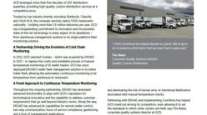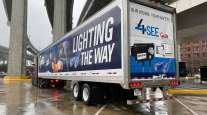Fleets Eye Camera Systems to Replace Mirrors
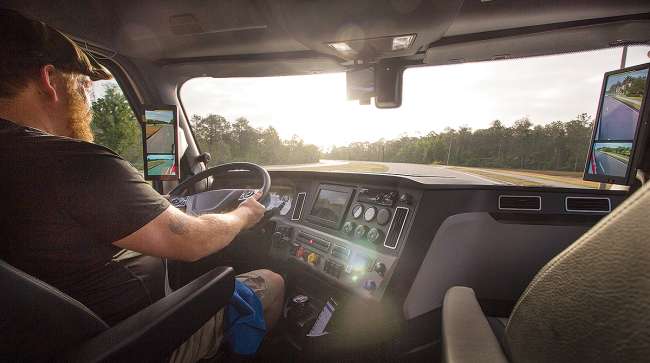
Camera monitor systems designed to replace a truck’s conventional side mirrors are getting favorable reviews from drivers, according to executives at fleets that are testing the new technology, which also recently received a nod of approval from federal regulators.
Maverick Transportation and Schneider have been testing the MirrorEye camera-based system from Stoneridge Inc.
RELATED: CVSA: Mirrors Have Role in Roadside Inspections
“The drivers who are driving the trucks with the MirrorEye system absolutely love it,” said Dean Newell, Maverick’s vice president of safety, and driver training. “We have five drivers using the system and all of them said that within the first week they got used to using the display screens almost exclusively.”
Thus far, fleets testing the aftermarket MirrorEye system have kept traditional mirrors in place on those trucks to comply with regulations, but that will no longer be a requirement in the years ahead. On Dec. 26, the Federal Motor Carrier Safety Administration announced it issued a five-year exemption allowing truck and bus operators to use Stoneridge’s mirrorless camera system in lieu of conventional mirrors.
Newell said Maverick’s drivers like the improved visibility from the camera system in inclement weather and at night.
“When it rains, they don’t have any of the problems that come with water on the mirrors,” Newell said.
Heaters in the cameras keep them free of frost and ice.
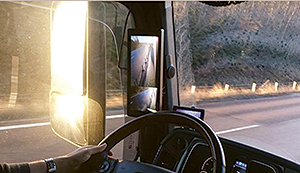
Camera systems can reduce glare for improved visibility. (Orlaco)
“They don’t fog up,” he said. “And the visibility is excellent at night. The system reduces glare from headlights so that you can see everything easily.”
Schneider has about 300,000 miles of experience with test trucks equipped with the MirrorEye system.
Fleets in North America have been testing MirrorEye prototypes, but Stoneridge has said production of commercial units will begin this year.
Based on accident-cost data, Stoneridge believes the payback period for its camera monitor product will be less than a year, Stephen Fox, the company’s vice president of business development, told Equipment & Maintenance Update in early December.
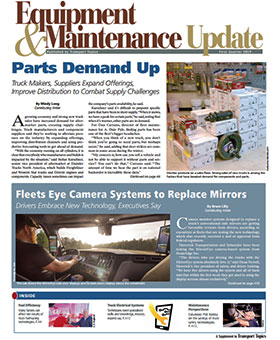
Thomas DiSalvi, vice president of safety and loss prevention at Schneider, said the camera system appears to provide a safety benefit, but it’s not easy to quantify given the smaller scale of the pilot program.
However, the drivers testing the technology “gave nearly-immediate feedback on how much better they could see in wet weather and in low-light conditions,” DiSalvi said.
Green Bay, Wis.-based Schneider ranks No. 7 on the Transport Topics Top 100 list of for-hire carriers in North America.
Another feature is the camera’s ability to change the field of view.
“The camera pans out as you turn so that the driver never loses sight of the rear corners of the trailer during the turn,” Maverick’s Newell said. “This can help to eliminate the situations where trailers end up in the ditch because the driver couldn’t see in the side-view mirror exactly where the rear end of the trailer was going.”
Newell added that the camera monitor system will improve lane changes because there are no blind spots down either side of the truck.
Removing the mirrors could help fleets save money. The camera arms on each side of the truck are more aerodynamic than the larger conventional mirrors, and the reduced drag could improve fuel efficiency.
Schneider plans to conduct fuel-consumption testing.
“The safety improvement, along with fuel savings, may strengthen the [return on investment],” DiSalvi said.
In some cases, the driving force for adoption of this technology will be more about safety than ROI.
“In terms of evaluating the benefits of this technology, the first thing we think about is the accidents and injuries that it could prevent,” Newell said.
If removing the mirrors improves fuel efficiency by reducing aerodynamic drag, that’s a bonus, but fuel improvement is secondary, he said. “I want to keep the focus on the safety side of this technology.”
Cargo Transporters, another fleet that is expecting to test the MirrorEye system, also sees safety as the key reason to consider the technology.
“We ask the basic question — would a technology have a significant impact on safety? If we think it will, unless the cost is entirely prohibitive, we’ll do it,”Cargo Transporters Chairman John Pope said.
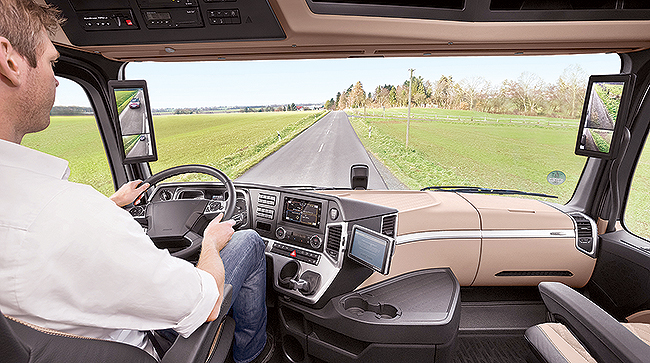
Displays for Bosch's system are positioned on the A-pillars in the vehicle. (Bosch)
Two other technology providers with camera monitor products are Bosch and Continental Automotive.
The digital side-view mirrors from Bosch will go into production in 2019, said Tim Wieland, manager of public relations for Bosch in North America.
“The system is available directly to OEMs and is not available in the aftermarket at this time,” he said.
Digital technology makes it possible to have a situation-specific display, according to Wieland.
“When the truck is driving on the highway, the driver can see further behind the vehicle, while in cities the angle of view is made as large as possible to provide greater safety,” he said. The system uses sensor data to adjust the field of view as needed.
Continental Automotive, a division of Continental AG of Germany, offers the ProViu Mirror camera monitoring system.
Christopher Schrecke, head of media relations for commercial vehicles and aftermarket communications at Continental, said that the prototype tests yielded “excellent results” and that the technology is ready for OEM development.
The ProViu Mirror system is a replacement of the conventional mirrors, but product enhancements in the future may bring additional features, Schrecke said. For example, merging the mirror system with other systems, such as radar, would make it possible to use object-detection algorithms, which could alert the driver to potentially dangerous situations.
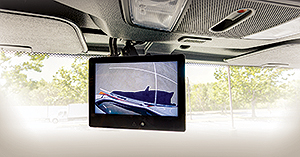
The MirrorEye viewing display for the look-down camera above the passenger door. (Stoneridge Inc.)
Meanwhile, when Pope, of Cargo Transporters, sat in a demo truck at American Trucking Associations’ 2018 Management Conference & Exhibition in Austin, Texas, he was struck by the view provided by a “look-down” camera on the passenger side of the cab.
According to Stoneridge’s Fox, this camera shows the driver the area on the passenger side of the cab between the front corner and the cab’s rear wheels.
Pope called this “one of the biggest advantages we saw.”
DiSalvi said Schneider’s test drivers particularly liked having this blind spot eliminated. The display for the look-down camera is typically mounted between the sun visors.
However, one of the concerns that comes with any new technology is reliability.
James Burg, president of James Burg Trucking Co., raised the question of how repairs to a damaged system would be handled.
“If the camera monitoring system goes down, how do you respond?” Burg asked. When a mirror is damaged, sending a repair technician out to a truck to handle it is clearly an option.
“The mirror can be repaired or an entirely new mirror can be put into place,” Burg said. “If the system goes down, the skill set required to fix it may be outside the range of most maintenance technicians.”
Fox, however, said that redundancy is built into the system. There are two cameras in each of the side-view camera arms, which means that if one camera fails, the other will provide a view of that side of the truck.
“In our 2 million miles of tests, we’ve found that it’s highly unlikely that the system will fail,” Fox said.
There is always the possibility of physical damage to the camera. However, damage to the camera arm is less likely than damage to a cab’s side-view mirror, Fox said, because the camera arm is placed higher on the cab. Also, the camera arm has a built-in breakaway feature and will fold in if it is struck by something as the truck moves forward.
“If the arm does somehow get broken off, you will lose your view of that side,” Fox said. “In that case, Stoneridge offers the means to supply emergency roadside assistance to replace broken camera arms.”
Another possible development is connecting camera monitoring systems with in-cab video systems from companies such as SmartDrive.
“We’ve analyzed these systems and can easily integrate the third-party cameras with the SmartDrive system,” said Jason Palmer, chief operating officer at SmartDrive. “Stoneridge, for example, has the necessary outputs that we can seamlessly pair with our platform.”
Fox agreed that there is potential for additional features, but said that currently, Stoneridge wants to emphasize the benefits from the product as it is now. “MirrorEye is our first product into this space to provide enhanced vision to the driver,” he said. “That’s our starting point.”



